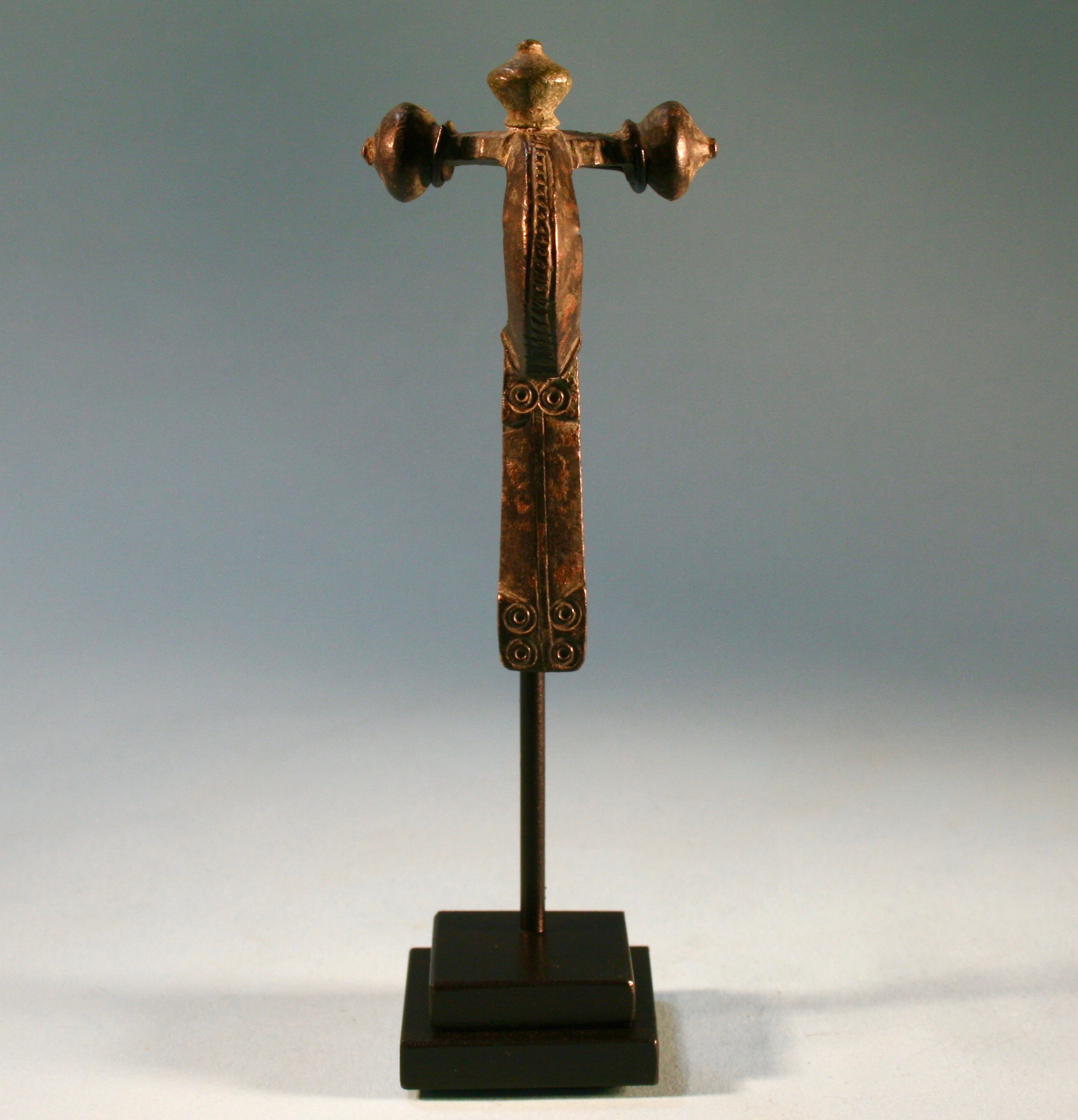

Title: Ancient Artifact Roman Soldier Bronze Crossbow Fibula Brooch
Shipping: $29.00
Artist: N/A
Period: Antiquity
History: Ancient Art
Origin: Southern Europe > Italy
Condition: Museum Quality
Item Date: N/A
Item ID: 862
Large Roman bronze crossbow fibula (brooch) with heavily knobbed cross and flat tail ornamented with incised annulets. These were used to hold robbing in place. One is unlikely to encounter a object like this outside a museum. This object was carefully selected and hand picked from thousands of pieces. Commonly worn by Roman soldiers, this one is complete and in excellent condition. Everything is intact, including the original pin, all three onion finials, and the catch plate (which holds the pin). Most are found with the pin or finials missing. It has a decoration on the high arching back and top of the catch plate. Found in the Balkans area of East Europe. Circa 3rd to 4th Century AD.
Link: http://en.wikipedia.org/wiki/Fibula_%28brooch%29
A Fibula (Latin "to fasten" is an ancient brooch. Technically, the Latin term fibulae refers specifically to Roman brooches, however, the term is widely used to refer to brooches from the entire ancient and early medieval world. Unlike modern brooches, fibulae were not only decorative, they originally served a practical function: to fasten clothes, including cloaks. Fibulae replaced straight pins that were used to fasten clothing in the Neolithic period and Bronze Age. In turn, fibulae were replaced as clothing fasteners in the Middle Ages by buttons. Their descendant, the modern safety-pin, remains in use today. There are hundreds of different types and variations of fibulae. They are usually divided into families or groups based on historical period, geography and/or cultural grouping. Fibulae are also divided into classes based on their general forms. Most fibulae are made of bronze (more properly “copper alloy”) or iron, or both. Some fibulae are made of precious metals such as silver or gold. Most fibulae are made of only one or two pieces. Many fibulae are decorated with enamel, semi-precious stones, glass, coral or bone. The body of a fibula is known as either the bow or the plate, depending on the basic form. A bow is generally long and narrow, and often arched. A plate is flat and wide. Plates could be solid or openwork. The body was often decorated. The head is the end of the fibula with the spring or hinge. The foot is the end of the fibula where the pin closes. Depending on the type of fibula, and the culture in question, the head of the fibula could be worn facing up, down or to the side. The pin that is used to fasten the clothing, is either a continuation of the fibula’s body or a separate piece attached to the body. The fibula is closed by connecting the end of the pin to a catch plate, or pin rest. The body and pin meet at either a spring or hinge. The earliest design is the spring which provides tension to the pin. The spring could be unilateral or bilateral. A unilateral spring winds around in one direction only. Unilateral springs are the earliest type, first appearing around the 14th century BC. Bilateral springs that wind around to both sides of the fibula body, appeared around the 6th century BC. Bilateral springs can be very short, with only one or two revolutions per side, or up to 10 cm long. Most bilateral springs are made of one piece of metal and therefore have a spring cord, a piece of wire extending from one end of the spring to the other. The spring cord can pass in front of or behind the fibulae body. Bilateral springs wrap around a pin or axle. These are usually made of iron even if the rest of the fibula and spring is copper alloy. In the 1st century AD some fibulae had springs that were concealed under a metal cover that was an extension of the fibula body. These are known as covered springs, or hidden springs. In the late 1st century BC or early 1st century AD a new design appeared in some bow type fibulae. A separate pin was attached to the head-end of the bow with a small hinge. In the second half of the 1st century AD, hinges were introduced to plate type fibulae. One or two small plaques were cast on the back of the plate and a pin was attached to them by a small hinge. Previously, plate type fibulae had bilateral springs attached to the back. In the 3rd century AD, the hinge was placed in the centre of a long transverse bar creating the famous Crossbow fibula design. A few fibulae from a much earlier date also had hinges, although this design feature was very rare and soon died out for nearly five centuries. For example, the Asia Minor Decorated Arc Fibula (Blinkenberg Type XII Variation 16) dating to the 5th century BC. It is important to note that different types of fibula construction were used contemporaneously. Though the introduction of the hinge was later than the introduction of the spring, the spring remained in use long after the hinge was introduced. Therefore, a given fibula with hinge is not necessarily more recent than one with a spring.